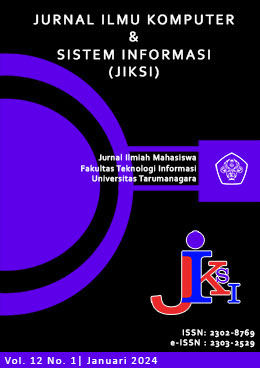APLIKASI PENJULAN PRODUK SARANG BURUNG WALET DMI MENGGUNAKAN METODE WATERFALL
Main Article Content
Abstract
Ram Swallow Nest DMI is a business engaged in sales. Where the sale of swallow nests at Ram Swallow Nest DMI is assessed from several aspects, namely in terms of shape, quality, weight and price. This sale is carried out manually where the seller and buyer make an agreement in advance for the location before the transaction occurs after the transaction agreement is made and the transaction is recorded manually into the note then must be transferred back manually into the sales ledger. So that sales and processing at Ram Swallow Nest DMI are less efficient and time consuming. Created a web-based sales system on sales and data processing Ram Swallow Nest DMI which aims to facilitate sales and recording transactions, increase efficiency and practical. And this website was also developed using HTML programming, CSS, Laragon database and Laravel framework.
Article Details

This work is licensed under a Creative Commons Attribution-NonCommercial-ShareAlike 4.0 International License.
This work is licensed under a Jurnal Komunikasi Creative Commons Attribution-ShareAlike 4.0 International License.
References
R. Triyanto, J. Stekpi, / Trilogi, T. Kalibata, and J. Selatan, “Rancang Bangun Aplikasi Penjualan Berbasis Website (Studi Kasus: Toko Waroeng Bola),” Jurnal Sistem Informasi dan Sains Teknologi, vol. 2, no. 1, 2020.
Y. Mulyanto, F. Handani, and Hasmawati, “RANCANG BANGUN SISTEM INFORMASI PENJUALAN PADA TOKO OMG BERBASIS WEB DI KECAMATAN EMPANG KABUPATEN SUMBAWA,” Jurnal JINTEKS, vol. 2, no. 1, Feb. 2020.
F. Eko Nugroho, “PERANCANGAN SISTEM INFORMASI PENJUALAN ONLINE STUDI KASUS TOKOKU,” Jurnal SIMETRIS, vol. 7, no. 2, 2016.
Y. Firmansyah and Jamilah, “Implementasi Sdlc Waterfall Dalam Pembuatan Game Edukasi Perjuangan Indonesia ”Hisotira” Menggunakan Rpg Maker Mv Berbasis Android,” JURNAL KHATULISTIWA INFORMATIKA, vol. 6, no. 2, Dec. 2018.
Z. Hakim, L. Sakuroh, and S. Awaludin, “Sistem Informasi Persediaan BarangBerbasisWebPada CV Telaga Berkat,” JURNAL SISFOTEK GLOBAL, vol. 9, no. 1, Mar. 2019.
E. Nurfitriana, W. Apriliah, H. Ferliyanti, H. Basri, and R. Ratnawati, “Implementasi Model Waterfall Dalam Sistem Informasi Akuntansi Piutang Jasa Penyewaan Kendaraan Pada PT. TRICIPTA SWADAYA KARAWANG,” Jurnal Interkom: Jurnal Publikasi Ilmiah Bidang Teknologi Informasi dan Komunikasi, vol. 15, no. 1, pp. 36–45, Apr. 2020, doi: 10.35969/interkom.v15i1.66.
T. Ahmad, J. Iqbal, A. Ashraf, D. Truscan, and I. Porres, “Model-based testing using UML activity diagrams: A systematic mapping study,” Computer Science Review, vol. 33. Elsevier Ireland Ltd, pp. 98–112, 2019. doi: 10.1016/j.cosrev.2019.07.001.
W. Steven Dharmawan et al., “Penerapan Metode SDLC Waterfall Dalam Perancangan Sistem Informasi Administrasi Keuangan Berbasis Desktop,” JURNAL KHATULISTIWA INFORMATIKA, vol. VI, no. 2, Dec. 2018.
S. S. Panigrahi, S. Shaurya, P. Das, A. K. Swain, and A. K. Jena, “Test Scenarios Generation Using UML Sequence Diagram,” in Proceedings - 2018 International Conference on Information Technology, ICIT 2018, Institute of Electrical and Electronics Engineers Inc., Dec. 2018, pp. 50–56. doi: 10.1109/ICIT.2018.00022.
M. Seidl, M. Scholz, C. Huemer, and G. Kappel, “UML @ Classroom, Undergraduate Topics in Computer Science,” Switzerland, 2015. [Online]. Available: www.allitebooks.com
B. Rawat and S. Purnama, “MySQL Database Management System (DBMS) On FTP Site LAPAN Bandung,” International Journal of Cyber and IT Service Management (IJCITSM), vol. 1, no. 2, pp. 173–179, 2021, doi: 10.34306/ijcitsm.v1i1.47.



